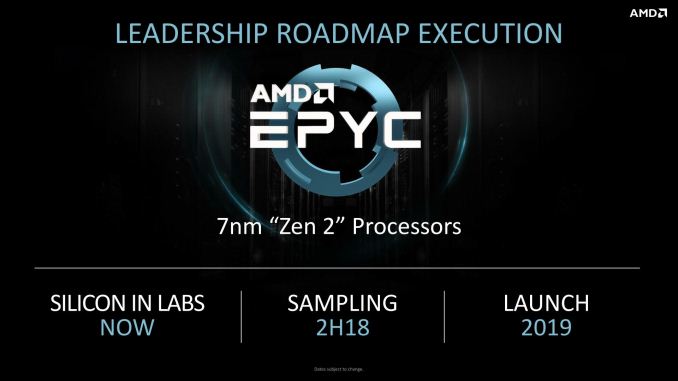AMD “Rome” EPYC CPUs to Be Fabbed By TSMC
by Ryan Smith on July 26, 2018 11:00 AM EST
Along with AMD’s epic quarterly results that were announced yesterday afternoon, there was also an interesting nugget buried in the earnings call for the results. We’ve known for some time now that AMD was going to be working with both TSMC and fraternal fab GlobalFoundries to produce 7nm products, similar to what they’ve done for their current-generation 16nm/14nm products. However until now it hasn’t been clear how those products would be allocated – whether TSMC will once again just produce semi-custom APUs, or if they’ll do more. But now we have an answer thanks to AMD’s earnings call, and the answer is indeed “more”.
Specifically, AMD CEO Lisa Su has announced that second-generation “Rome” EPYC CPU that the company is wrapping up work on is being produced out at TSMC. This is a notable departure from how things have gone for AMD with the Zen 1 generation, as GlobalFoundries has produced all of AMD’s Zen CPUs, both for consumer Ryzen and professional EPYC parts.
So, Matt, on your first question relative to the manufacturing of the second generation of EPYC, so as I said earlier, we are working with both the TSMC and GLOBALFOUNDRIES in 7-nanometer. As for the 7-nanometer Rome that we're currently sampling, that's being manufactured at TSMC.
As it stands, AMD seems rather optimistic about how things are currently going. Rome silicon is already back in the labs, and indeed AMD is already sampling the parts to certain partners for early validation. Which means AMD remains on track to launch their second-generation EPYC processors in 2019.
Unfortunately, the call offered no real insight as to why AMD has shifted to using TSMC for some of their CPUs for this upcoming generation. AMD’s hands are somewhat tied on fab choice in as much as they have quotas under their wafer share agreement with GlobalFoundries that they must fulfill. How AMD wants to split that up is up to them, but beyond that AMD hasn’t offered any information as to why they’ve made the choices they have.
Ultimately however if they are meeting their order quota from GlobalFoundries, then AMD’s situation is ultimately much more market driven: which fab can offer the necessary capacity and performance, and at the best prices. Which will be an important consideration as GlobalFoundries has indicated that it may not be able to keep up with 7nm demand, especially with the long manufacturing process their first-generation DUV-based 7nm “7LP” process requires.
Source: AMD Q2'18 Earnings Call










32 Comments
View All Comments
bill.rookard - Friday, July 27, 2018 - link
Ultimately, I'm thinking that the fact that AMD is producing the Rome CPUs at TMSC - means that they probably ARE meeting their quota with GF via the Ryzen/Vega chips. Thus, no penalties, especially since GF has been nearly at capacity.With the growth that was apparent in enterprise on the latest AMD report, I think they really want to get a bunch of Epyc server CPUs ready for market now they had some time to validate them.
eastcoast_pete - Friday, July 27, 2018 - link
I believe that this decision has mainly to do with TSMC being able to do 7 nm now, whereas GloFo isn't ready yet, AND by going with TSMC, AMD will have bragging rights over Intel on the "nm front". With this move, AMD can point to their big server chips being manufactured in a 7 nm process, even after Intel gets their server chips in 10 nm up-and-running. If AMD had waited for GloFo to get 7 nm online, no such differentiator in time for ZEN2 EPYC's launch.